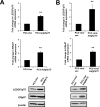LEDGF/p75 Overexpression Attenuates Oxidative Stress-Induced Necrosis and Upregulates the Oxidoreductase ERP57/PDIA3/GRP58 in Prostate Cancer
- PMID: 26771192
- PMCID: PMC4714844
- DOI: 10.1371/journal.pone.0146549
LEDGF/p75 Overexpression Attenuates Oxidative Stress-Induced Necrosis and Upregulates the Oxidoreductase ERP57/PDIA3/GRP58 in Prostate Cancer
Abstract
Prostate cancer (PCa) mortality is driven by highly aggressive tumors characterized by metastasis and resistance to therapy, and this aggressiveness is mediated by numerous factors, including activation of stress survival pathways in the pro-inflammatory tumor microenvironment. LEDGF/p75, also known as the DFS70 autoantigen, is a stress transcription co-activator implicated in cancer, HIV-AIDS, and autoimmunity. This protein is targeted by autoantibodies in certain subsets of patients with PCa and inflammatory conditions, as well as in some apparently healthy individuals. LEDGF/p75 is overexpressed in PCa and other cancers, and promotes resistance to chemotherapy-induced cell death via the transactivation of survival proteins. We report in this study that overexpression of LEDGF/p75 in PCa cells attenuates oxidative stress-induced necrosis but not staurosporine-induced apoptosis. This finding was consistent with the observation that while LEDGF/p75 was robustly cleaved in apoptotic cells into a p65 fragment that lacks stress survival activity, it remained relatively intact in necrotic cells. Overexpression of LEDGF/p75 in PCa cells led to the upregulation of transcript and protein levels of the thiol-oxidoreductase ERp57 (also known as GRP58 and PDIA3), whereas its depletion led to ERp57 transcript downregulation. Chromatin immunoprecipitation and transcription reporter assays showed LEDGF/p75 binding to and transactivating the ERp57 promoter, respectively. Immunohistochemical analysis revealed significantly elevated co-expression of these two proteins in clinical prostate tumor tissues. Our results suggest that LEDGF/p75 is not an inhibitor of apoptosis but rather an antagonist of oxidative stress-induced necrosis, and that its overexpression in PCa leads to ERp57 upregulation. These findings are of significance in clarifying the role of the LEDGF/p75 stress survival pathway in PCa.
Conflict of interest statement
Figures









Similar articles
-
Pathway specific gene expression profiling reveals oxidative stress genes potentially regulated by transcription co-activator LEDGF/p75 in prostate cancer cells.Prostate. 2012 May 1;72(6):597-611. doi: 10.1002/pros.21463. Epub 2011 Jul 27. Prostate. 2012. PMID: 21796653 Free PMC article.
-
Alternative splicing and caspase-mediated cleavage generate antagonistic variants of the stress oncoprotein LEDGF/p75.Mol Cancer Res. 2008 Aug;6(8):1293-307. doi: 10.1158/1541-7786.MCR-08-0125. Mol Cancer Res. 2008. PMID: 18708362 Free PMC article.
-
The stress oncoprotein LEDGF/p75 interacts with the methyl CpG binding protein MeCP2 and influences its transcriptional activity.Mol Cancer Res. 2012 Mar;10(3):378-91. doi: 10.1158/1541-7786.MCR-11-0314. Epub 2012 Jan 24. Mol Cancer Res. 2012. PMID: 22275515 Free PMC article.
-
LEDGF/p75: a novel nuclear autoantigen at the crossroads of cell survival and apoptosis.Autoimmun Rev. 2003 Sep;2(5):290-7. doi: 10.1016/s1568-9972(03)00063-6. Autoimmun Rev. 2003. PMID: 12965181 Review.
-
LEDGF/p75-mediated chemoresistance of mixed-lineage leukemia involves cell survival pathways and super enhancer activators.Cancer Gene Ther. 2022 Feb;29(2):133-140. doi: 10.1038/s41417-021-00319-3. Epub 2021 Apr 1. Cancer Gene Ther. 2022. PMID: 33795806 Review.
Cited by
-
Glucocorticoid Receptor Regulates and Interacts with LEDGF/p75 to Promote Docetaxel Resistance in Prostate Cancer Cells.Cells. 2023 Aug 11;12(16):2046. doi: 10.3390/cells12162046. Cells. 2023. PMID: 37626856 Free PMC article.
-
Targeting epigenetic protein-protein interactions with small-molecule inhibitors.Future Med Chem. 2020 Jul;12(14):1305-1326. doi: 10.4155/fmc-2020-0082. Epub 2020 Jun 19. Future Med Chem. 2020. PMID: 32551894 Free PMC article. Review.
-
LEDGINs, Inhibitors of the Interaction Between HIV-1 Integrase and LEDGF/p75, Are Potent Antivirals with a Potential to Cure HIV Infection.Adv Exp Med Biol. 2021;1322:97-114. doi: 10.1007/978-981-16-0267-2_4. Adv Exp Med Biol. 2021. PMID: 34258738
-
Twenty years of research on the DFS70/LEDGF autoantibody-autoantigen system: many lessons learned but still many questions.Auto Immun Highlights. 2020 Feb 3;11(1):3. doi: 10.1186/s13317-020-0126-4. Auto Immun Highlights. 2020. PMID: 32127038 Free PMC article. Review.
-
The Emerging Roles of the Stress Epigenetic Reader LEDGF/p75 in Cancer Biology and Therapy Resistance: Mechanisms and Targeting Opportunities.Cancers (Basel). 2024 Nov 26;16(23):3957. doi: 10.3390/cancers16233957. Cancers (Basel). 2024. PMID: 39682146 Free PMC article. Review.
References
Publication types
MeSH terms
Substances
Grants and funding
LinkOut - more resources
Full Text Sources
Other Literature Sources
Medical
Research Materials
Miscellaneous

